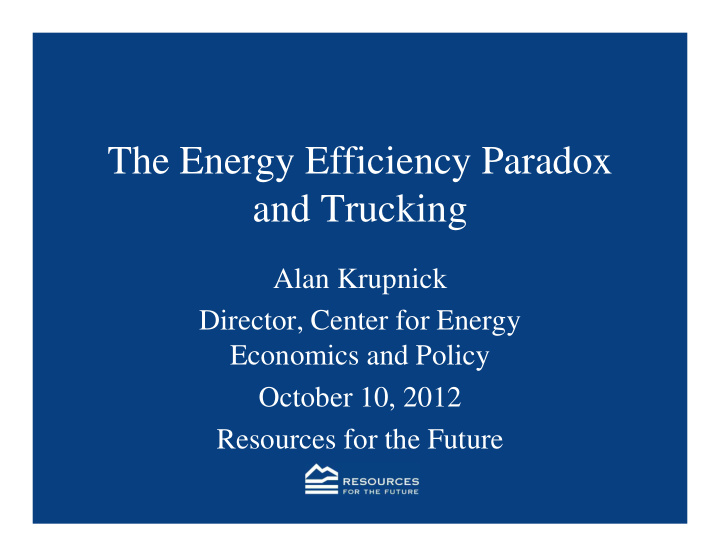



The Energy Efficiency Paradox and Trucking Alan Krupnick Director, Center for Energy Economics and Policy October 10, 2012 Resources for the Future
Economic rationale for fuel efficiency investment • Buy if PDV of fuel savings > Investment Cost � PDV: i, lifetime of vehicle/investment � Fuel savings: Price of fuel(t o � T), EE factor, quantity of fuel used (t o � T) • Payback period: time where PDV fuel savings= Inv cost • Complications � What i? � Uncertainty over vehicle/investment life, resale value � Uncertainty over future fuel prices, uncertainty about energy savings factor, miles driven over time, ancillary costs � Investment financing, maintenance costs
What is the Energy Efficiency Paradox? • Fuel saving investments “available” but not being used • If true, particularly surprising since this is a for-profit sector. • The conventional wisdom in the trucking industry is that investments in energy efficiency require a two-to-three year payback in fuel economy savings, and yet the investments will continue to generate fuel savings over a far longer period.
Why do companies demand such a short payback period? • Market failure: � government intervention justified � can count “full” PDV fuel savings as benefit • Hidden costs: � no intervention � reduce benefits appropriately
Economic rationale for fuel efficiency investment • Buy if PDV of fuel savings > Investment Cost � PDV: i, lifetime of vehicle/investment � Fuel savings: Price of fuel(t o T), EE factor, quantity of fuel used (t o T) • Payback period: time where PDV fuel savings= Inv cost • Complications (green is hidden costs; red is market failure) � Uncertainty over future fuel prices, miles driven over time, ancillary costs � Uncertainty about energy savings factor
Telling anecdote on hidden costs “Reducing power to take loads up hills will induce drivers to go around rather than up the mountains, which can lead to increases in fuel use” (comment by steel supplier who has a fleet of trucks)
Treatment of energy efficiency in the Truck CAFE RIA • Assumed market failure is the cause; therefore the “engineering” cost savings are real and should be counted. • Also assumed a given technology penetration in a given fleet size and given rebound effect. But these depend on the actual/perceived costs � Could hold on to vehicles longer � Purchase less expensive or less regulated vehicles � E.g., LDA’s to LDVs
-$240 $6,600
Conclude on RIA • Although reasons for the standard are energy security and climate change, most benefits are from fuel savings, so treatment of EEP is critical to justifying rule. • Fortunately, costs (and fuel economy gains) are modest this time around � NRC: 50% improvement possible � 7-24% required • So need to solve the EEP
Recommend
More recommend